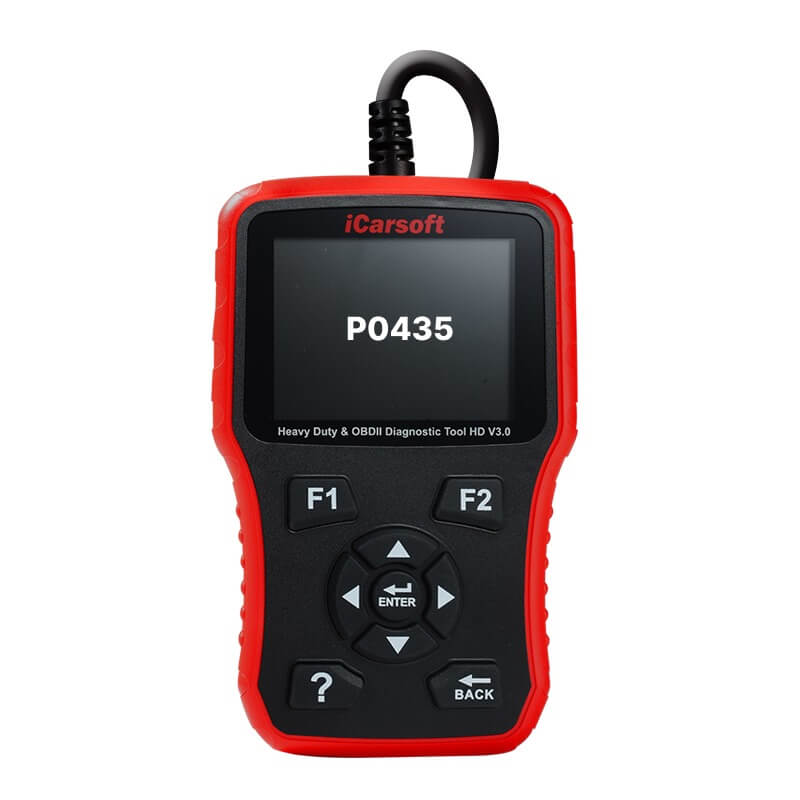P0435 – Catalyst Temperature Sensor Bank 2
POSTED IN pcodes
Welcome to our article on the P0435 code, which pertains to the Catalyst Temperature Sensor Bank 2. This code indicates a problem with the engine bank that does not contain cylinder #1. The Powertrain Control Module (PCM) analyzes data from the oxygen sensors to determine the proper exhaust composition and temperature. If the signal sent to the PCM falls outside the expected parameters, the code will be triggered.
The most common causes for the P0435 code are a faulty catalytic converter or bad oxygen sensors. Other possible causes include fuel in the exhaust system, improper fuel usage, a faulty mass airflow sensor, fuel injector malfunction, a faulty fuel regulator, a coolant temperature sensor malfunction, a damaged or leaking flex hose, or faulty spark plug timing. The symptoms of the P0435 code can range from a lit Check Engine Light and a stored DTC to engine stalling or a no-start condition.
Continue reading to learn more about the symptoms, diagnosis, common mistakes, repairs, and technical description of the P0435 code.
Key Takeaways:
- The P0435 code refers to the Catalyst Temperature Sensor Bank 2, indicating a problem in the engine bank without cylinder #1.
- The most common causes of the code are a faulty catalytic converter or bad oxygen sensors.
- Other possible causes include fuel in the exhaust system, improper fuel usage, or various sensor malfunctions.
- Symptoms range from a lit Check Engine Light to engine stalling or a no-start condition.
- Diagnosis involves scanning the vehicle’s computer, capturing data, measuring exhaust pipe temperature, and inspecting sensor wiring.
Symptoms of the P0435 Code
When the P0435 code is triggered, the symptoms can vary depending on the underlying issue. In some cases, the only noticeable symptom may be a Check Engine Light illuminating on the dashboard and a stored Diagnostic Trouble Code (DTC). However, more severe symptoms may manifest, indicating a more serious problem.
- Engine Stalling: One of the potential symptoms of the P0435 code is engine stalling. If the issue causing the code affects the engine’s combustion process or fuel delivery, it can result in the engine stalling unexpectedly.
- No-Start Condition: Another possible symptom is a no-start condition. This means that when you try to start the vehicle, the engine fails to crank or start.
- Poor Engine Performance: If the P0435 code is related to a malfunctioning catalytic converter or oxygen sensors, it can lead to poor engine performance. You may experience reduced power, hesitation, or a rough running engine.
- Hissing Noises: In some cases, you may hear hissing noises coming from the engine or exhaust system. This can be an indication of an exhaust leak, which can trigger the P0435 code.
- Check Engine Light: The most common and noticeable symptom of the P0435 code is the illumination of the Check Engine Light on the dashboard. This serves as an indication that there is a potential issue with the catalyst temperature sensor in Bank 2.
If you experience any of these symptoms, it is recommended to have your vehicle inspected and diagnosed by a qualified technician. They will be able to pinpoint the exact cause of the P0435 code and recommend appropriate repairs or replacements to resolve the issue.
Buy tested tuning file for Adblue / EGR / DPF / Adblue off now!
Diagnosing the P0435 Code
To accurately diagnose the P0435 code, mechanics follow a set of diagnostic procedures. These steps involve scanning the vehicle’s computer, capturing data, measuring exhaust pipe temperature, monitoring oxygen sensor function, inspecting sensor wiring, and visually inspecting the catalytic converter.
The diagnostic process begins with a scan of the vehicle’s computer to retrieve any stored trouble codes, including concurrent codes that may provide additional insights into the issue. Mechanics also clear any existing diagnostic trouble codes (DTCs) and road test the vehicle to confirm whether the problem is intermittent or persistent.
One important diagnostic step involves measuring the temperature of the exhaust pipe before and after the catalytic converter. This is done using specialized tools to ascertain if the converter’s temperature readings are within the expected range. Deviations from the normal temperature range can indicate a malfunctioning catalytic converter.
Another crucial step is monitoring the oxygen sensor function. By using a scanner and oscilloscope, mechanics can observe the sensor’s operation and ensure it is generating the correct voltage and responding appropriately to changes in exhaust gas composition.
In addition, mechanics inspect the sensor wiring and connections to identify any faults or damage that may interfere with proper sensor operation. They also visually inspect the catalytic converter for any visible signs of damage or malfunction, such as cracks, leaks, or clogging.
To further assess the functionality of the oxygen sensors, mechanics compare the readings of the upstream and downstream sensors. This comparison helps determine if the sensors are functioning correctly and providing accurate data to the vehicle’s computer.
Overall, the diagnostics for the P0435 code involve a comprehensive evaluation of various components and systems, including scanning the computer, capturing data, measuring temperatures, monitoring sensor function, inspecting wiring, and visually inspecting the catalytic converter. This thorough approach ensures accurate identification of the underlying issue and facilitates effective repairs.

Diagnostic Procedures for the P0435 Code:
- Scan the vehicle’s computer to retrieve trouble codes, including concurrent codes.
- Clear any existing diagnostic trouble codes (DTCs) and perform a road test to determine if the issue is intermittent or persistent.
- Measure the temperature of the exhaust pipe before and after the catalytic converter using specialized tools.
- Monitor oxygen sensor function using a scanner and oscilloscope.
- Inspect sensor wiring and connections for faults or damage.
- Visually inspect the catalytic converter for signs of damage or malfunction.
- Compare readings of the upstream and downstream oxygen sensors to ensure proper functionality.
Common Mistakes When Diagnosing the P0435 Code
When diagnosing the P0435 code, there are several common mistakes that technicians should avoid. By understanding and avoiding these errors, you can ensure an accurate diagnosis and effective repair for your vehicle.
Mistake 1: Replacing O2 Sensors Without Verification
One of the most common mistakes when diagnosing the P0435 code is replacing the oxygen sensors without verifying that they are actually malfunctioning. This hasty approach is often taken to avoid the costly replacement of the catalytic converter. However, simply replacing the sensors may not address the underlying issue causing the code. It is crucial to conduct proper testing and diagnostics to confirm the need for sensor replacement.
Mistake 2: Ignoring Concurrent DTCs
Another common mistake is failing to address any concurrent Diagnostic Trouble Codes (DTCs) that may be present. Ignoring these additional codes can result in repeated catalytic converter failure. It is important to thoroughly diagnose the entire system and address any related codes before assuming the repair is complete.
“Avoid the common mistakes of replacing O2 sensors without verification and ignoring concurrent DTCs to ensure an accurate diagnosis for the P0435 code.”
Proper Diagnostic Procedure
To avoid these common mistakes, follow a comprehensive diagnostic procedure for the P0435 code. This involves:
- Scanning the vehicle’s computer and capturing data, including any concurrent codes.
- Testing and verifying the operation of the oxygen sensors before considering replacement.
- Addressing any additional DTCs present to prevent repeated catalytic converter failure.
- Thoroughly inspecting the entire system and conducting necessary tests before concluding the repair.
By following these steps and avoiding common mistakes, you can accurately diagnose and resolve the P0435 code, ensuring optimal performance and efficiency for your vehicle.
Troubleshooting Table
| Mistake | Consequence |
|---|---|
| Replacing O2 sensors without verification | Does not address underlying issue causing the code |
| Ignoring concurrent DTCs | Potential for repeated catalytic converter failure |
Severity and Repairs for the P0435 Code
The severity of the P0435 code can vary depending on the specific issue causing the code. One of the most concerning problems associated with the P0435 code is catalytic converter failure. A faulty catalytic converter can lead to decreased engine performance and potentially cause further damage if not addressed promptly. Additionally, catalytic converter failure can result in problems with emissions testing, especially in states where testing is mandatory.
To resolve the P0435 code, there are several potential repairs that may be required. In addition to addressing the issue with the catalytic converter, it is essential to diagnose and repair any other Diagnostic Trouble Codes (DTCs) that may be present. These could include issues related to O2 sensors, fuel mixture, fuel trim, or misfire codes. A thorough inspection and diagnosis are necessary to identify and resolve all underlying issues contributing to the code.
Given the complexity of diagnosing and repairing the P0435 code, it is highly recommended to seek the assistance of a qualified technician. A qualified technician will have the necessary tools, equipment, and expertise to efficiently diagnose the problem and perform the required repairs. This helps to ensure that the issue is properly resolved, preventing any further damage to the engine and ensuring optimal performance.
Example Repairs for the P0435 Code:
| Repair | Description |
|---|---|
| Replacement of Catalytic Converter | If the catalytic converter is determined to be faulty, it may need to be replaced. This is a critical repair to restore proper engine performance and emissions control. |
| Diagnosing and Repairing Other DTCs | Addressing any other Diagnostic Trouble Codes (DTCs) that may be present is crucial in resolving the P0435 code. This could involve repairs related to O2 sensors, fuel mixture, fuel trim, or misfire codes. |
| O2 Sensor Replacement | If faulty O2 sensors are contributing to the P0435 code, they may need to be replaced. This is important for accurate monitoring of the exhaust composition and temperature. |
| Fuel System Inspection and Repair | Inspecting and repairing any issues with the fuel system, including fuel mixture imbalance and fuel trim issues, can help resolve the P0435 code. This ensures proper fuel consumption and combustion. |
| Engine Misfire Repair | If the P0435 code is related to engine misfire, diagnosing and repairing the misfire issue is necessary. This could involve addressing spark plug timing, ignition coil malfunction, or other misfire causes. |
Technical Description of the P0435 Code
The P0435 code is a generic OBD-II trouble code that pertains to a malfunction in the circuit of the catalyst temperature sensor. This sensor is responsible for monitoring the temperature of the catalytic converter, which is crucial for proper emission control. When the sensor detects an issue, it triggers the P0435 code.
The catalytic converter plays a vital role in reducing harmful gases in the exhaust system by converting them into water and carbon dioxide. Its efficiency is monitored by oxygen sensors, with one located upstream and one downstream of the catalytic converter. In the case of the P0435 code, the malfunction pertains to the bank 2 sensor 1, which is positioned upstream of the catalytic converter.
To provide a clear understanding, let’s break down the code:
- OBD-II trouble code: This code is part of the standardized system used by all vehicle manufacturers to diagnose and report issues in the onboard computer system.
- Catalyst temperature sensor malfunction: The code specifically indicates a problem with the catalyst temperature sensor, which is responsible for monitoring the temperature of the catalytic converter.
- Bank 2 sensor 1: This refers to the specific location of the sensor within the engine. In this case, bank 2 refers to the side of the engine that does not include cylinder #1, and sensor 1 denotes that it is located upstream of the catalytic converter.
It’s important to note that there may be related diagnostic codes, such as P0436, P0437, and P0438, which all pertain to various issues with the catalyst temperature sensor and related systems.

| Diagnostic Data | Possible Causes |
|---|---|
| Fault Code | P0435 |
| Diagnostic Trouble Code (DTC) Type | Generic |
| Description | Catalyst Temperature Sensor Circuit Low Voltage (Bank 2, Sensor 1) |
| Possible Causes |
|
By understanding the technical description and possible causes of the P0435 code, you can effectively diagnose and resolve the issue with the catalyst temperature sensor malfunction.
Causes and Diagnostic Procedures for the P0435 Code
The P0435 code can be triggered by several factors, including a faulty oxygen sensor, wiring problems, an exhaust air/fuel mixture imbalance, or a faulty PCM. To diagnose the code and pinpoint the root cause, a mechanic will typically conduct a series of diagnostic procedures.
Diagnostic procedures may vary depending on the specific vehicle, but they often start with a visual inspection. During the visual inspection, the mechanic will carefully examine the components, checking for loose connections, damaged wiring, or any exhaust leaks that may interfere with the proper functioning of the system.
Additionally, the mechanic will also check if there are any technical service bulletins related to the specific issue. These bulletins can provide valuable information and guidance for the diagnostic process.
Next, the diagnostic process typically involves checking the operation of the oxygen sensor. This includes testing both the upstream and downstream sensors to ensure they are functioning correctly and providing accurate readings.
| Diagnostic Procedures for the P0435 Code |
|---|
| 1. Visual Inspection: Check for loose connections, damaged wiring, or exhaust leaks. |
| 2. Check Technical Service Bulletins: Look for any relevant bulletins related to the issue. |
| 3. Check Sensor Operation: Test the operation of the oxygen sensor, both upstream and downstream. |
| 4. Test Circuit for Continuity: Ensure the circuit is functioning properly and has no disruptions. |
Another crucial step in the diagnostic process is checking the circuit for continuity. The mechanic will ensure that the circuit is properly connected, without any interruptions or disruptions that could affect the sensor’s performance.
If any faults or issues are found during the diagnostic process, the mechanic will need to address and repair them accordingly. This may involve replacing a faulty oxygen sensor, repairing damaged wiring, restoring proper air/fuel mixture balance, or fixing any PCM-related problems.
In the next section, we will explore common mistakes that can occur when diagnosing the P0435 code and the potential consequences of neglecting this issue.
Conclusion
In conclusion, the P0435 code indicates a malfunction in the catalyst temperature sensor bank 2. The severity of the code can vary depending on the specific issue causing it, but it is crucial to address the problem promptly to maintain proper engine performance and emissions control. Diagnostic procedures for this code typically involve visual inspection, checking sensor operation, and testing the circuit.
If you are experiencing the symptoms associated with the P0435 code or are unable to diagnose and repair the issue yourself, it is highly recommended to seek the assistance of a qualified technician. They have the expertise and equipment necessary to efficiently identify and resolve the problem, ensuring your vehicle’s optimal functionality and compliance with emissions regulations.
By addressing the P0435 code and resolving the underlying issue, you can avoid potential engine problems, improve fuel efficiency, and mitigate harmful emissions. Regular maintenance and prompt attention to diagnostic trouble codes are essential for maintaining the longevity and reliability of your vehicle.
FAQ
What does the P0435 code refer to?
The P0435 code refers to the Catalyst Temperature Sensor Bank 2. It indicates a problem with the engine bank that does not contain cylinder #1.
What are the symptoms of the P0435 code?
The symptoms can vary, but common ones include a Check Engine Light, engine stalling, poor engine performance, hissing noises, and a no-start condition.
How is the P0435 code diagnosed?
Diagnosis typically involves scanning the vehicle’s computer, measuring exhaust pipe temperature, monitoring oxygen sensor function, and visually inspecting the catalytic converter.
What are some common mistakes when diagnosing the P0435 code?
Common mistakes include replacing oxygen sensors without verifying malfunction, not addressing concurrent DTCs, and assuming the repair is complete without thorough diagnosis.
How severe is the P0435 code and what repairs are needed?
Severity can vary, but it’s important to address the issue to prevent further damage. Repairs may include addressing other DTCs and seeking the assistance of a qualified technician.
What is the technical description of the P0435 code?
The P0435 code is a generic OBD-II trouble code that refers to a malfunction in the catalyst temperature sensor (bank 2, sensor 1).
What are the common causes and diagnostic procedures for the P0435 code?
Common causes include faulty oxygen sensors, wiring problems, an exhaust air/fuel mixture imbalance, or a faulty PCM. Diagnostic procedures involve visual inspection, checking sensor operation, and testing the circuit.
What is the conclusion about the P0435 code?
In conclusion, the P0435 code refers to a catalyst temperature sensor malfunction in bank 2. It is important to diagnose and address the issue to ensure proper engine performance and emissions control.


